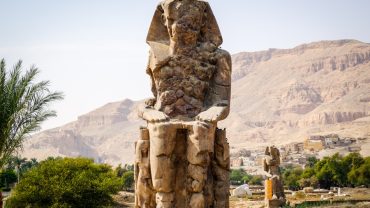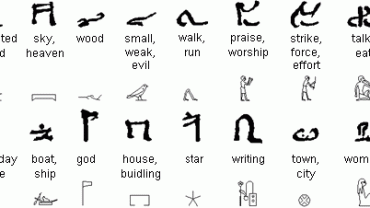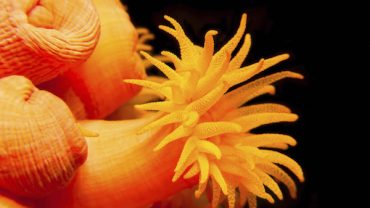Khonsu: The Egyptian God of the Moon, Healing, and Travel
Introduction
Khonsu, the Egyptian god of the Moon, was a powerful figure in ancient Egyptian mythology. His name, meaning „Traveler,“ reflects his connection to the Moon’s journey across the sky. Known as the god of time, fertility, and protection, Khonsu influenced lunar cycles, timekeeping, and agriculture. Depicted as a man with the head of a hawk or crocodile, Khonsu also held the power to heal the sick, protect travelers, and ensure prosperity through the Nile’s flooding.
As the son of Amun and Mut, Khonsu was part of the Theban triad and worshipped widely across Egypt, with his temple in Thebes being one of the most sacred religious sites.
The Role of Khonsu in Egyptian Life
Khonsu’s impact on Egyptian life extended from the celestial realm to daily existence, influencing agriculture, healing, and protection.
1. Lunar Cycles and Time
- Khonsu was the god of the Moon, which governed time and life cycles in Egypt.
- The lunar calendar dictated:
- Religious festivals like the New Year.
- Agricultural seasons for planting and harvesting.
- The Nile’s flooding cycles, vital for fertile soil.
2. Protector of Travelers
- Khonsu’s power extended to nighttime travel, where he acted as a guardian for those journeying under the Moon’s light.
- He was also considered a protector of those venturing into unfamiliar or dangerous regions.
3. Fertility and Prosperity
- Khonsu’s role in fertility was closely tied to the flooding of the Nile, which brought abundance and renewed life to the land.
- His association with the Moon symbolized growth, renewal, and prosperity for all of Egypt.
4. Healer of the Sick
- Khonsu was revered as a healing deity, often called upon to cure illnesses and dispel evil spirits.
- Inscriptions and myths describe his interventions in restoring health to the ailing.
The Worship of Khonsu
Khonsu was deeply respected across Egypt, and his worship was characterized by grand rituals and ceremonies.
1. Rituals and Ceremonies
- Priests in the Temple of Khonsu in Thebes performed rituals to honor the god, which included:
- Food and drink offerings to appease him.
- Performances of music, dance, and chants to celebrate his power.
- Rituals were often aligned with lunar phases, emphasizing his connection to the Moon.
2. Sacred Statues
- Statues of Khonsu were:
- Housed in temples and placed in tombs for protection.
- Made from stone, bronze, and wood, often painted or gilded to enhance their sacred appearance.
- They depicted Khonsu in his various forms, including:
- A man with the head of a hawk or crocodile.
- Holding a crook and flail, symbols of kingship.
- Wearing a lunar disk on his head, reflecting his celestial role.
Khonsu in Ancient Egyptian Art
Khonsu’s imagery played a significant role in Egyptian art and religious expression.
1. Iconography
- Common artistic representations of Khonsu include:
- Human form with the head of a hawk or crocodile.
- A lunar disk and crescent on his head.
- Holding the crook and flail, emphasizing his authority.
2. Placement and Use
- Statues and reliefs of Khonsu were prominent in:
- Temples like the Temple of Khonsu in Thebes, where they were central to rituals.
- Tombs, where they served as protective elements for the deceased.
3. Amulets and Decorative Art
- Amulets bearing Khonsu’s image were used to invoke his blessings, including:
- Protection from harm.
- Fertility and healing powers.
Symbolism of Khonsu
| Symbol | Meaning |
| Crook & Flail | Authority, kingship, and protection. |
| Lunar Disk | Connection to the Moon and celestial power. |
| Hawk Head | Divine vision and insight. |
| Crocodile Head | Strength, adaptability, and renewal. |
The Temple of Khonsu in Thebes
The Temple of Khonsu, located within the Karnak complex in Thebes (modern-day Luxor), was a center for his worship. Its significance lies in its grandeur and alignment with Khonsu’s lunar symbolism.
Key Features
- Sacred Statues: Housed in the temple’s inner sanctum, used for rituals.
- Ceremonial Spaces: Included areas for offerings, prayers, and celebrations.
- Astrological Alignments: The temple’s architecture reflected its connection to celestial events.
Religious Importance
- The temple was a focal point for pilgrimage and worship, attracting devotees from across Egypt.
- Priests managed the temple’s operations, ensuring the proper observance of Khonsu’s rites.
Legacy of Khonsu
Khonsu’s legacy endures through surviving texts, statues, and temples. His influence can be seen in:
- Modern archaeology: Discoveries of his artifacts provide insights into ancient Egyptian religion.
- Tourism: Sites like the Temple of Khonsu in Luxor draw visitors from around the world.
- Academic study: Research into lunar deities highlights Khonsu’s importance in timekeeping and fertility.
Conclusion
Khonsu’s role as the god of the Moon highlights his profound impact on ancient Egyptian religion, culture, and daily life. Through his influence on time, fertility, protection, and healing, Khonsu remains a symbol of celestial power and renewal. The worship of Khonsu in Thebes and his depictions in art continue to captivate modern scholars and enthusiasts, preserving his legacy as one of Egypt’s most revered deities.
Discover the history of ancient Egypt and the life of the pharaohs through the best packages of pyramid tours of Egypt and a visit to Luxor and Aswan
Choose from over 100 offers tour programs in Hurghada, Sharm El Sheikh, Marsa Alam or Cairo



























Comment (0)